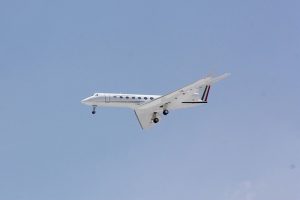
Airplanes are often classified according to their tail assembly. There are T-tail airplanes, for instance, that feature a traditional T-shaped tail assembly. They have a single vertical fin that extends into two horizontal stabilizers on the sides. There are also V-tail airplanes. V-tail airplanes aren’t as common as T-tail airplanes, but they are still found in the skies.
Overview of V-Tail Airplanes
V-tail airplanes are characterized by the use of a V-shaped tail assembly. The V-shaped tail assembly serves the same task as the conventional horizontal and vertical stabilizers found on most other airplanes: It stabilizes the airplane so that pilots can fly straight.
V-tail airplanes simply have a V-shaped tail assembly consisting of two flight surfaces that originate at the base of the airplane’s tail and extend diagonally outward and away from each other. At the end of each surface is a separate hinged flight control surface. These hinged flight control surfaces — which pilots can control — are known as ruddervators.
How the V-Shaped Tail Assembly Works
All V-tail airplanes have a V-shaped tail assembly. It eliminates the need for traditional vertical and horizontal tail surfaces. Rather than featuring separate vertical and horizontal tail surfaces, V-tail airplanes feature a single V-shaped tail assembly. The V-shaped assembly consists of two angled flight control surfaces that extend diagonally outwards to form the shape of the letter V.
Disadvantages of V-Tail Airplanes
V-tail airplanes have some unique advantages over other types of airplanes. V-shaped tail assemblies, for instance, are better at reducing drag than traditional T-shaped tail assemblies. The unique V shape minimizes drag.
Another benefit of V-tail airplanes is improved performance at high speeds. They are typically more stable than other types of airplanes when flying at high speeds. Many military airplanes use a V-shaped tail assembly for this reason.
Disadvantages of V-Tail Airplane
There are still some disadvantages associated with V-tail airplanes. One of the main disadvantages is that they require larger fuselages than airplanes with a traditional T-shaped tail assembly. If the fuselage isn’t long enough, the airplane may succumb to snaking. Snaking is a phenomenon in which an airplane shakes uncontrollably to the left and right — similar to the way in which a snake slithers across the ground.
V-tail airplanes are also somewhat uncommon. Most airplanes use a traditional T-shaped tail assembly. Because they are less common than their T-shaped counterparts, not all pilots know how to fly V-tail airplanes.



